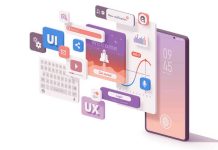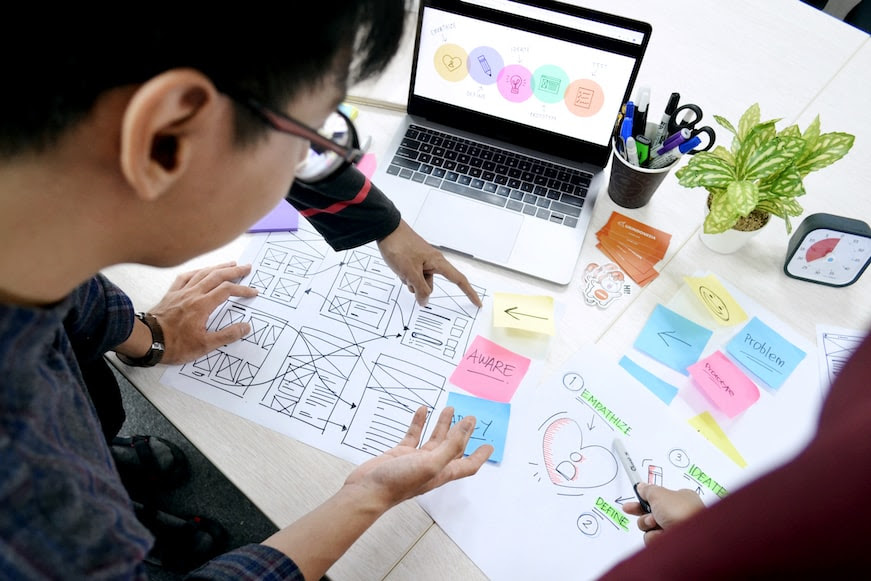From Deliveroo to Grab, every app is built for a purpose. So, it’s super important that you define your objectives and vision before you develop a mobile app.
If you are here, I am assuming that you have already done your homework. So, without further ado, let’s start with our topic of discussion.
Steps to Develop a Mobile App from Scratch
The app development process has so many steps that it can be confusing sometimes. That’s the very reason to segregate these steps into different phases.
- Pre-development Phase
- Development Phase
- Post-Development Phase
The reason is quite simple. Dividing a project into phases allows a project manager to create milestones, sprints and delivery charts. You will get more clarity as we dig deep into the app development process.
1. Pre-Development Phase

Be it refining your idea based on current market trends or visualization of the final product, your tech partner will cover everything related to this during this phase.
Here, you will need to answer the following questions:
- What are your preferences as brand guidelines?
- What are the demographics of your customers?
Answering these question leads to the next steps, which involves the creativity and market understanding of two different tech teams of an app design agency, mainly the UX team.
a. Market Research
Your UX team will explore the pain points of your customers and creates a user journey map. This is entirely based upon UX-backed research which includes understanding your customer’s needs and behavior patterns.
You can also call it an idea discovery workshop that enables you as well as your design team to understand the product better and lay the right foundation. This market research and UX design process can take up to 3 week’s time.
With feedback and market data in hand, you make the decisions on the following two aspects:
- Sitemap and information architecture
- User experience map, flows and journeys
Leveraging user psychology knowledge and understanding the deliverable of a design team includes a lot of assets. Like technical specifications of your product, competitive analysis report, user personas report, sitemap architecture, experience maps, user flows and journey report.
The final outcome of this process is a UX wireframe, which leads us to the next step.
b. Visualization of your App

Based on the deliverables from the UX team, now your app is ready for design. This is the process that allows you to visualize, test your idea with early app adopters and even raise funding.
The UI deliverables involve the final design screens and a prototype. Depending upon your reason to build a prototype, you can take either of the following two routes:
- Build a low-fidelity prototype first
- Directly go for a high-fidelity prototype
For a better understanding, check out this article on low-fidelity vs high-fidelity prototypes.
Once your prototype is ready, the pre-development phase is complete. You can make it the first milestone to develop a mobile app.
But before we dive deeper into that, let’s take a moment and talk about a quicker way to be out there in the market with your product.
That way is to go for a progressive web app. As you already know, these types of apps work seamlessly on both the web and mobile. If this is something that you want to explore, here’s your guide on the benefits of PWA which can help you achieve your business goals.
Okay, let’s come back now to our topic today and talk about the second step in the process to build a mobile app.
2. The Development Phase

This is where the actual development starts. To start, you will need to decide on the technology stack that will power your mobile app.
And it goes by first choosing between a native and hybrid app development approach. If you need help, this quick article on the benefits of native apps can clear some thoughts in your mind.
But to summarize, native apps are costly and hence perform better. Whereas, hybrid apps come with the advantage of launching an app for iOS and Android simultaneously in your budget.
Irrespective of what option you choose, here you need to have a tech partner, in this case, a reputed mobile app development company by your side.
Your tech partner can help you decide on the right technology stack for your mobile app. Usually, this is done considering your budget, target audience type and their expectations, the scope of the project, security concerns and future scalability.
The next step in the process to develop a mobile app is to build an engineering, preferably a remote development team. This engineering team may or may not include:
- Front-end developers
- Back-end developers
What is Frontend and Backend Development, You May Ask?
a. Front-end development: This is the process where front-end app engineers will create the interface of your mobile app. Some of the top programming languages for building your app interface are reactjs and angularjs.
b. Back-end development: During this process, the developers write the actual code that lays the foundation of your app modules and functionalities. Additionally, they build or integrate APIs required to support your app functionality. The preferred programming languages for custom coding are Nodejs and hybrid app development are Flutter and React Native.
If you opt for hybrid app development, then this guide on choosing between React Native and Flutter could be worth reading.
Testing is at the Core of the Developing a Mobile App
To ensure that the application runs smoothly, it is crucial that you create multiple sprints or checkpoints for different modules/functionalities before you actually develop a mobile app. At the end of every sprint, the code must be thoroughly tested for its quality and user experience. For your reference, below is the list of testing stages:
1. Documentation Testing
This testing involves removing the discrepancies in the layout and navigation of the app’s screens, along with other crucial elements that are concealed in the design.
2. Functional Testing
This method aids you in ensuring that your app responds as per industry guidelines.
3. Usability Testing
You can perform user experience testing to ensure that your app offers convenient browsing to all of your customers and is designed to function in accordance with industry standards.
4. Compatibility Testing
This ensures that your mobile app is compatible with all the devices on the market, regardless of their size, version, screen resolution, or hardware.
5. Performance Testing
This allows you to test how well you develop your own mobile app and perform under a specific workload.
6. Security Testing
This process determines whether your application is vulnerable to security threats. Furthermore, it protects sensitive data and detects risks such as hacking, viruses, and unauthorized access.
7. Certification Testing
Your app will be evaluated to ensure it meets industry standards, terms and conditions, licensing agreements, and store requirements such as those found on Google Play, the App Store, as well as Windows Phone Store.
3. Post-Development Phase

How will your customers know that there is a new app in the market unless and until you promote it? The best app won’t make any difference if nobody knows about it.
In order to reach your target audience, you have to let them know there is an app that can meet their specific needs. Having an active presence across multiple marketing platforms is essential for marketing your app.
It may be more effective to concentrate on a specific platform where your consumers spend the most time. Keeping your app up-to-date and innovating after a while is the key to keeping it viable.
In addition to app speed, uptime, and adaptation, you should provide new features periodically to keep users interested. Tracking key performance indicators is the best way to keep your users updated.
For a detailed understanding, here’s a quick guide on how to market an app successfully.
How to Monetize your Mobile App?

After an app is deployed to the Play Store, there is a lot you can do to make it monetized. There are different types of monetization methods for different types of apps. Let’s take a look at some of those.
1. Freemium Models
Freemium mobile apps can be downloaded for free by users. While the basic features of the app can be enjoyed for free, certain features and content may require payment.
2. Advertisements
Advertising is the most common method of monetizing apps. Ads in your mobile app will only be effective if you have a large database of users. Your users will see highly targeted ads without compromising their experience.
3. In-App Purchases
In-app purchases are popular with gaming apps like Clash of Clans or Candy Crush. Through in-app purchases, users can unlock unique features, costumes, and in-game money in these gaming apps.
Make sure your in-app purchases enhance the user experience instead of hampering it if you’re considering them. It is important that each purchase contributes to the overall value that users get rather than solely creating profits for the company.
4. Subscriptions
A free trial period may be an appropriate option if you plan to offer a subscription model for your app. When the free trial period ends, the user membership converts automatically to a paid one.
In terms of monetization, subscriptions offer recurring income that is reliable and profitable. As a result, your paying customers may expect your app to offer more content and features.
5. Sponsorship or Partnership
Sponsorships refer to an app collaborating with advertisers. If users perform specified behavior in the app, sponsors will reward them with rewards/benefits.
The concept of partnerships refers to collaborating with an app that has a similar customer base to yours. Your products and services benefit from this win-win situation that allows you to attract new customers.
The Immediate Steps to Take After You Develop and Launch your App

After the app launch, it’s important that you put everything in place perfectly so your business thrives. The following points must be taken into consideration when releasing the app:
1. App Store Optimization
The aim of ASO is to improve your app’s ranking in the app stores with keywords, titles, and descriptions. You can optimize your app metadata to increase the visibility of your app within the app store.
2. Email Marketing
Do not forget to inform your email subscribers of the launch of your app.
3. User Feedback
Identifying the user’s feedback will assist in analyzing an app’s performance in the market. It is possible for your users to provide feedback by commenting or leaving a review. Providing people with a chance to participate on Instagram or Facebook pages is also a great way to engage with them. Customer feedback is always helpful in improving and growing the app’s functionality.
4. App Analytics
The other method is using App analytics where you can see how popular your app has become. Knowing the demographics of the users, for example, their age, their location, or where most of them are, can help you focus more on the target audience.
Disclaimer: We are a Certified Mixpanel Partner that helps businesses to implement digital product analytics correctly.
5. App Maintainance:
Plan on maintaining your app by identifying the users’ demands. Integrating new features and fixing the bugs is what you need to upgrade after a period of time so users start loving it.
6. Tracking & Adjusting Strategies
You must establish and track KPIs in order to ensure your app runs well technically, provides an excellent user experience, and is generating revenue for you.
But one important question is still there. Did you forget it?
How to Find the Right Tech Team to Develop Your Mobile App?

It’s quite simple and complicated. Why simple because you simply have to follow some steps to narrow down the best app development companies. And complicated because it requires your gut and sense to decide on the right partner.
Here are the steps that will help you create a list of top app development companies:
1. Onshoring vs Nearshoring vs Offshoring
You have to choose between these three outsourcing strategies. Most companies prefer building their remote tech teams from offshore locations, as it is a strategic move.
2. Spend Some Hours on Research Work
Go to Clutch or any other reputed B2B review and rating platform to get a pre-vetted list of top app development companies in your preferred region.
3. Get Free Consultation
From your understanding of the project/business, review their website, mobile app portfolio and market reputation. If it looks good, just simply ask for a free consultation from their team.
You can evaluate them by considering the factors like their suggestions, the process and methodologies they follow, their experience with similar projects, the time and estimation involved, etc.
4. Trust your Gut
Now, it’s time to trust your gut and make the right decision.
Final Thoughts
The application development stages are quite overwhelming and tedious. But, it is a rewarding process if you do it in the right manner. As we have come to end, let’s answer some of the frequently asked questions by business owners before developing an app.
How long does it take to create a mobile app?
There are a wide variety of factors that determine the time it takes to build an app. Developing a timeline depends on a number of factors, including the type of app, the complexity of its features, and how it is created.
Just to give you an idea, a basic app could take 2 months, medium complexity apps can take up to 3 or 4 months and highly complex apps can take up to 12 months of time.
What is the cost to develop a mobile app?
Like mentioned above, to determine the cost of developing a mobile app from scratch, many factors need to be considered: how you build the app, what features you implement, and what type of development method you use. Apps become more complex as you add more features.
For a detailed understanding, feel free to check out this guide on the cost of developing an app in Singapore.








